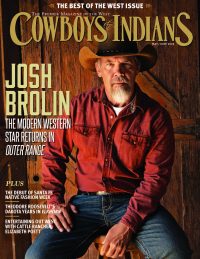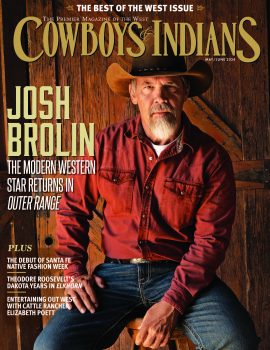The Sons of Katie Elder, John Wayne’s first movie after he “licked the Big C,” turns 50.
The first time we see John Wayne in The Sons of Katie Elder, the image is appropriately iconic.
After his character, errant gunfighter John Elder, is frequently and sometimes fearfully discussed by blood relatives and mortal enemies for the first several minutes of the movie, he finally appears on a hilltop, silently gazing down at the graveside gathering for his recently departed, dearly beloved mother. He waits for the dispersal of the mourners — including his brothers Tom (Dean Martin), Matt (Earl Holliman), and Bud (Michael Anderson Jr.) — before he slowly rides down to pay his own respects.
As Elder bids farewell to the mother he sorely disappointed during her life, we have no doubt whatsoever that he will find and punish those who made much of that life even more miserable. And while he’s at it, he’ll drop the hammer on those responsible for the still-unsolved murder of her husband, his father, years earlier. Because, hey, a man’s got to do what a man’s got to do. And this man is portrayed by no less a larger-than-life figure than John Wayne.
As we celebrate the 50th anniversary of the release of The Sons of Katie Elder, it may be hard to imagine — or, if you’re old enough, remember — that this 1965 movie very well might have showcased another star as its protagonist. But the story behind the story of this enduringly popular western is in many ways more fascinating than what appears on-screen: Before John Elder could find justice in his hometown of Clearwater, Texas, John Wayne first had to cheat death in real life.
Wayne was originally set to start filming The Sons of Katie Elder on October 20, 1964. He had been offered a great deal (by 1964 standards) for his participation in the Paramount production: a $600,000 salary, plus one third of the profits and another third of the negative. Better still, he would be working again with veteran director Henry Hathaway, with whom he had previously collaborated on films as diverse as The Shepherd of the Hills (1941), North to Alaska (1960), and Circus World (1964); and singer-turned-actor Dean Martin, with whom he had generated an improbably potent chemistry while costarring in Howard Hawks’ Rio Bravo (1959).
On September 13, however, Wayne received the frightful diagnosis that, all too often at that time, was considered a death sentence: He had a cancerous tumor in his left lung.
The next day, Wayne broke the news to Hathaway and producer Hal Wallis, and suggested another actor — perhaps Kirk Douglas — might be recast as John Elder. Wallis responded by saying he would postpone the start of production, and keep postponing it until when — not if, but when — The Duke recovered from lifesaving surgery.
Actually, it took two surgeries: the first to remove the entire upper lobe of the left lung; the second to ameliorate endemic swelling. To his credit, Wayne soon went public with his story of surviving cancer, hoping to encourage others his age to get regular checkups. During a December 29, 1964, press conference at his home, the 57-year-old actor announced: “They told me to withhold my cancer operation from the public because it would hurt my image. ... Here’s what I believe. Isn’t there a good image in John Wayne beating cancer? Sure, I licked the Big C.”
But his battle had just begun.
On January 6, 1965, after a four-month delay, production began on The Sons of Katie Elder in Durango, Mexico. “I had just gotten over that cancer operation,” Wayne told an interviewer years later, “and I thought I could hear myself breathing all the time.” In the view of Randy Roberts and James S. Olson, authors of the 1997 biography John Wayne: American, Wayne survived the rigors of on-location filming in the Mexican location through sheer willpower. “At the high elevation,” they marveled, “Duke labored for breath, sucking constantly on an oxygen inhalator. His work was a gritty effort by a weak man.”
By all accounts, however, director Hathaway made few allowances for Wayne’s debilitated condition. Indeed, according to Charles “Chuck” Roberson, Wayne’s longtime stunt double, the director — who had survived his own battle with colon cancer years earlier — was a demanding taskmaster who sneered at Wayne’s request to wear a wetsuit during a fight scene in icy water beneath a woodland bridge. “You’d look too fat,” Hathaway reportedly said. “Don’t baby yourself.”
“I guess [Hathaway] figured that even if Duke turned blue in the effort,” Roberson recalled in his autobiography, The Fall Guy: 30 Years as The Duke’s Double, “he was going to do the same work with one lung as he did before with two.”
Surprising no one more than himself, Wayne rose to the challenge. During 46 days of production, Roberson wrote, “Duke did just about as much as he had ever done, and the only way he let anybody know when he had pushed himself too far was by getting grouchy.”
For example, there was the time Wayne had to take a few generous whiffs from his oxygen tank after an especially rough action scene. Unfortunately, a photojournalist on set chose that particular moment to snap a shot of the superstar. Even more unfortunately, Wayne wasn’t so occupied with his oxygen mask that he didn’t note the intrusion on his personal space.
As Roberson tells the story:
“What do you think you’re doing?” Duke yelled, throwing the mask down.
The reporter got white and about three feet shorter. “Nothing, Mr. Wayne. Sorry, Mr. Wayne. Didn’t mean to, Mr. Wayne.”
He ripped the back of his camera open and tore out the film and threw it on the ground like it was poison. “There. It’s gone. That’s the end of it.”
Only it didn’t end there. The humiliated photojournalist repeatedly apologized —
and then apologized a few times more — until Wayne himself began to feel a bit embarrassed. After hearing the umpteenth “I’m sorry,” Wayne replied: “Quit saying that, or I’m liable to get really mad.”
“Duke smiled sheepishly,” Roberson writes, “and that was the end of it.”
Wayne remained every inch the thoroughgoing professional throughout the arduous production of The Sons of Katie Elder, determined to prove that he had indeed “licked the Big C” and was back in the saddle, literally as well as figuratively. If he ever resented Hathaway’s demanding drill-sergeant style of directing, he chose not to hold a grudge — and, just four years later, gladly re-teamed with the director for True Grit (1969), the movie for which he won his only Academy Award for Best Actor.
Some biographers have theorized that The Sons of Katie Elder was an invaluable boon to John Wayne, in that it convinced him that working hard at what he did best was the way to continue cheating death. Such armchair psychology is usually of dubious value while taking the measure of any man. But in Wayne’s case — well, maybe there is something to the notion that there’s nothing like a brush with death to reignite one’s work ethic. Wayne played lead roles in no fewer than 17 more feature films (including 1968’s The Green Berets, which he also directed) before finally succumbing to stomach cancer in 1979 at age 72.
Toward the end of his life, Scott Eyman recounts in John Wayne: The Life and Legend, “Wayne would call Henry Hathaway ‘the meanest man in the business. He worked me like a goddamn dog. And you know something? It was the best thing that ever happened to me. It meant I got no chance to walk around looking for sympathy.’
“Hathaway’s lack of nurturing,” Eyman adds, “was therapeutic — maddening, painful, but therapeutic.”
After The Sons of Katie Elder, Wayne went on to film six more westerns in Durango — The War Wagon (1967), The Undefeated (1969), Chisum (1970), Big Jake (1971), The Train Robbers (1973), and Cahill, U.S. Marshal (1973) — often with many of the same supporting players and production personnel. (Character actor Bruce Cabot appeared variously as a Texas Ranger, a villainous rancher, and, in Big Jake, a loyal Native American scout named Sam Sharpnose.) The location became a sort of second home for the aging actor, leading author David Morrell (First Blood), a fervent admirer, to surmise that The Duke “regarded Durango’s fairly constant cast and crew as a version of a family, one that he could depend upon, possibly because he had undisputed control.”
Despite his high regard for Wayne, however, Morrell writes in his book-length essay John Wayne: The Westerns that “the Durango films look suspiciously like the clichéd ‘B’ movies of Wayne’s early years,” and he quotes Pilar Wayne, The Duke’s third wife, as offering a similar appraisal: “Looking back, I can barely tell those Durango films from one another. They had a sameness of story, plot and location which seemed like a disservice to Duke’s fans.”
Nonetheless, both she and Morrell acknowledge that The Sons of Katie Elder and the other Durango westerns — along with the more critically acclaimed True Grit, The Cowboys (1972), and The Shootist (1976) — were quite successful at the box office and, in Pilar Wayne’s words, “cemented [John Wayne’s] heroic, larger-than-life image in the minds of his fans.”
Millions of moviegoers — many of them curious to see just how Wayne looked and sounded after his much-publicized bout with “the Big C” — flocked to theaters when The Sons of Katie Elder was released in the summer of 1965. Paramount reported ticket sales of $13.3 million, enough for the western to rank No. 15 on the year’s list of top-grossing Hollywood releases. (True Grit, another Paramount release, grossed $31 million and ranked No. 7 in 1969.) Reviews were generally respectful; a few, downright appreciative. Although New York Times critic Howard Thompson felt compelled to describe the movie as “gory” twice in his review, he praised it as a “good, tough, unpretentious” western showcasing Wayne “in a part that fits him with bullet precision.”
Looking back at the film nearly a half-century later, Scott Eyman gets to the heart of the matter when he waxes lyrical about the “ineffable image of grace” that was the death-defiant Duke on-screen: “The loose amble of Stagecoach had altered to a very specific walk — arms raised at the elbow, trunk leaning slightly forward, leading with his narrow hips, often coming to rest with a hip cocked in the contrapposto pose of classical Greek statuary.
“The youthful beauty had faded,” Eyman concedes, “but Wayne compensated for that and his extra girth with a continuing Apollonian grace — movement in a mythic rhythm.”
A man may die, but his movies remain forever in the present tense. The story behind the story of The Sons of Katie Elder is not merely the victory of a vengeful son over black-hearted villains. It is the triumph of a beloved superstar over his own mortality.
The John Wayne Cancer Foundation funds cancer research, education, awareness efforts, and support. Visit www.johnwayne.org for events and more information.












